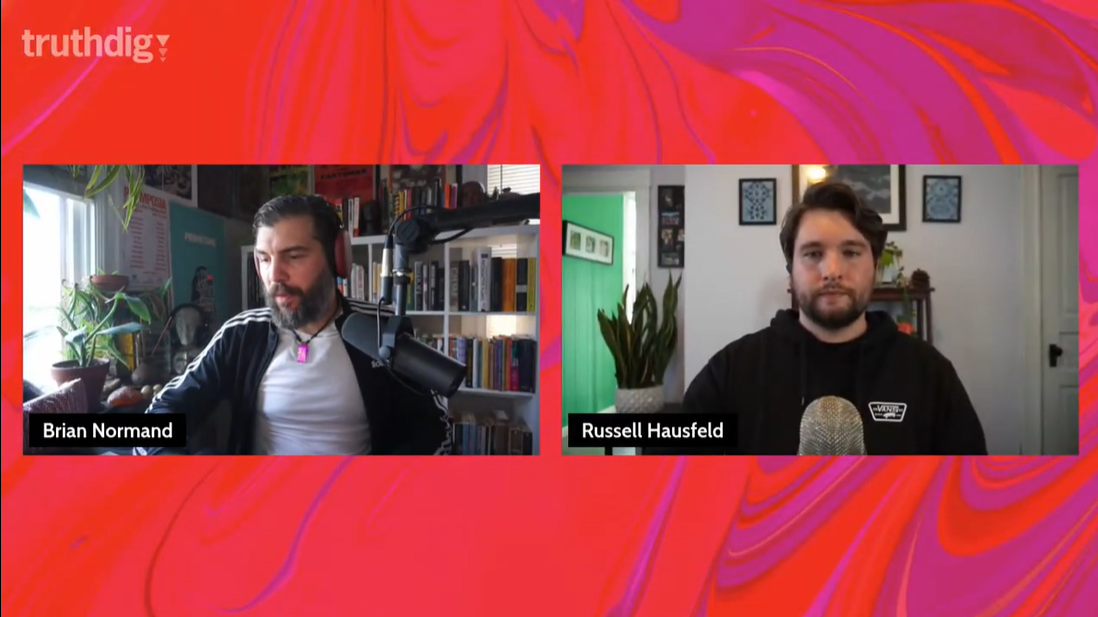The Psychedelic Renaissance and the Military
Watch the video and read the transcript from Truthdig's recent livestream event. This is Part of the "The Ecstasy of Agony" Dig series
This is Part of the "The Ecstasy of Agony" Dig series
Zuade Kaufman: Hello, and welcome. I’m Zuade Kaufman, publisher of Truthdig. Truthdig brings you well-reported provocative stories that are rarely discussed. We’re excited to bring this live event, “The Psychedelic Renaissance and Military,” as part of our Dig, “The Ecstasy of Agony”. This investigative series covers how the military became a target demographic for psychedelic therapy. This discussion today, stems from the Dig, and we are going to center on the past, present and future connections between the military and psychedelics, both in this discussion and as we dive deeply in the Dig. So, our expert, who is our Dig curator Russell Hausfeld, has been leading this investigation for Truthdig over several months. Previously, he published widely on this subject. And now he continues to add to our Dig as new developments in the field occur. Russell will be interviewed by Brian Normand, who has collaborated with some of the most influential people working in psychedelics and drug policy. In 2014, he co-founded Psymposia, a nonprofit focused on drugs, policy and culture. This organization functions as a watchdog organization that monitors abuse in the psychedelic field. I want to thank Brian and Psymposia for co-sponsoring this event with Truthdig. And now I turn you over to the experts.
Brian Normand: Alright. Yeah, thank you Zuade. I just want to say thanks to everyone at Truthdig for making this happen. So yeah, I guess we’re just gonna dive right into this. So Russ, one of the phrases that we’re going to be discussing today, and something that’s pretty central to your writing, and anybody that’s been following psychedelics for the last handful of years now, we all hear the phrase “psychedelic renaissance.” So before we get into the other questions today, can you just explain what that phrase means for viewers who aren’t really familiar with that concept? And you know, break it down a little bit?
Russell Hausfeld: Yeah, absolutely. I’d also like to thank Truthdig, for setting this all up. It’s really cool. I kind of think of the psychedelic renaissance as kind of starting over the last decade, but I think you could probably go back a little bit further than that into the ’90s. And it really kind of started as a way to describe the resurgence of psychedelic research, kind of, after there was a drought of research for a few decades. The United States government criminalized psychedelics in the late ’60s. And after that happened, research funding for psychedelic projects, which had been going on in the ’50s-’60s kind of dried up, as did access to research drugs for psychedelic trials and things like that. As that died off, research died off and the countercultural scene sort of flourished. And then towards the late ’80s, early ’90s. There was sort of this resurgence of psychedelic research, sort of beginning with organizations like or individuals like Rick Strassman, who did a bunch of work on DMT research. The Johns Hopkins psilocybin research team started some really influential research in the psychedelic field around that time as well. And an organization called MAPS, which is the Multidisciplinary Association for Psychedelic Studies, who I think we’ll be talking about in a little bit, was doing research into the drug MDMA. And, to me, the psychedelic renaissance, also, kind of towards the tail end here of where we are now with the psychedelic renaissance, there’s also the kind of inclusion of venture capital and Big Pharma interest in the space that I think can’t go without saying. This research kind of picked back up and so did interest from traditional venture or traditional pharma and venture capital outlets, to the point where the first for-profit psychedelic company kind of popped off in 2016. And today where we are in 2023, there’s over 50 for-profit companies, I think over 50 publicly listed for-profit companies, even with investors, like technocratic billionaires like Peter Thiel, Christian Angermeyer, Mike Novogratz. I was just reading a Business Insider article that was estimating that sometime in the future, the industry could be worth some $100 billion. I don’t know where they’re getting those numbers exactly, but I think it’s a good indication of how people are discussing the scene anymore. It kind of went from this academic research explosion into this kind of explosion of corporate and investor interest within the last few years.
BN: Yeah, and so you mentioned MAPS, Multidisciplinary Association for Psychedelic Studies, they’re pretty central to your writings and they’re essentially like the backbone of the psychedelic renaissance. So, you know, we’re going to talk about them a bunch today. You’ve written a lot of your piece, they’re the central player in a lot of your work. So can you just kind of orient the audience, just explain MAPS a little bit, and sort of, what is their significance in the space?
RH: Yeah, absolutely. Like you said, they’re central to a lot of my reporting. And a lot of that is because like you said, they are kind of this backbone of the psychedelic industry, the psychedelic renaissance. Most of the public relations messaging and kind of the things people talk about a lot of that came through MAPS. They’re a nonprofit that was started in the late ’80s, by a man named Rick Doblin. He started it as… MDMA was being rescheduled for higher penalties and things, and he and a group of therapists started an organization called Earth Metabolic Design Laboratories, which he split from, started MAPS and began doing cannabis and MDMA research. The organization sort of fronted as a unique organization in the space, it’s a nonprofit, doing pharmaceutical clinical trial research, which is unique, you don’t really see that that’s kind of unheard of. They’re currently in phase three trials with MDMA. Early on, and throughout most of MAPS’ lifetime, I think they benefited from a lot of countercultural buy-in and seeming like they were part of a countercultural scene, but they have kind of been the gatekeepers who opened the gates to a lot of the pharma interest that is currently in the space. So MAPS executive director, Rick Doblin, has, for instance, gone on record saying he believes that sort of the for-profit pharma venture capital interest in the space is a sign of MAPS’ success.
BN: And so, your Dig is called “The Ecstasy of Agony” and part one is “A Long, Strange Loop”. So what basically, what is worth highlighting? Why did you find that worth highlighting? That piece? Why was that piece something that you were interested in sort of going deeper on?
RH: Yeah, sure. Um, it kind of, part of it actually stems back to the beginning of my writing career in general. I was just out of high school, gifted a very generous scholarship to start my writing scholarship, or my writing career, from a family who lived on my street who lost a son. He died of suicide while in Iraq in 2010. His name was Jacob Dornwind. And that was like, kind of central to the beginning of my career, even going to school to be a writer. And so watching that fallout from that tragedy in our community, and in their family, was pretty impactful on me early on, and just thinking about military mental health and why service members’ mental health deteriorates in the first place. So cut to about five or six years later and I’m starting my journalism career and covering cannabis and psychedelics and this renaissance atmosphere that’s happening. I just began seeing more and more marketing towards the military, more kind of pandering towards military mental health in this field. And while I do think there are truly a lot of people out there who want to get these substances in the hands of veterans and military personnel who are suffering, because they truly think it’s going to help, I also think there is some use of military marketing and imagery support that are being used for strategic angles to sort of mainstream these drugs and to mainstream sort of the psychedelic pharmaceutical agendas. MAPS has been one of the organizations that is sort of central to this marketing and they’ve been fairly open about their strategies if you’ve kind of read between the lines or just read the exact lines of things they’ve published. So what got me interested in the first piece, “Long, Strange Loop,” was that I wanted to explore this strategy. And so the ethical considerations and motives behind marketing to military mental health in this field. There was also this kind of, our colleague, David Nichols, at Psymposia has written a lot about sort of the irony of military and police becoming this idealized treatment demographic for psychedelic therapy. And so I kind of wanted to explore that a little bit, too. And the Dig kind of exploded from there, because there were just so many angles that I realized could be explored with the relation between psychedelia and the military from there. So that was kind of what inspired the “Long, Strange Loop” piece was this idea that, I guess I didn’t say this, but a lot of the early countercultural psychedelic figures were introduced to things like LSD through military experimentation, and then it was criminalized. And now they’re kind of… the loop has closed to where the military is now, sort of, once again, the idealized treatment demographic or testing ground for these drugs, which it was not for a long time.
BN: Yeah. And so for you what was what was interesting, what was sort of ironic about the military being that ideal demographic?
RH: Well, just that for decades, the military and the police were sort of the face of the criminalization of these drugs, and the enforcers of the drug war. And that right-wing kind of politicians and stuff, we’re sort of the proponents of anti-drug policies and programs like D.A.R.E. and sort of miseducating children around these substances and things like that. So there just was this kind of deep irony around the fact that the script had sort of flipped, and now all of these previously enforcement, arms of the drug war, were being spotlit as ideal treatment demographics for the movement and being sort of used to “Trojan Horse” psychedelic policies and psychedelic acceptance into right-wing spheres where they had previously not been popular or had been stigmatized.
BN: And is this… is the political strategy, this mainstreaming political strategy, was that something with MAPS that was… was that there early on? How did that develop? Has that been something that’s been a strategy all along since back in 1986?
RH: Yeah, it really wasn’t. It was kind of a touchy subject in their public relations for a while. I think MAPS may have even been aware that some people who supported them might find that a little distasteful to market to sort of the organizations that were criminalizing the supporters of their organization. And it really wasn’t until about the early 2000s, that things really took off in the United States. MAPS began attempting to do research outside of the United States in the ’90s. That would have implied potential treatment of veterans, potential treatment of the military in places like Nicaragua and Israel. They had some projects that they were looking to do there, but it was really 2005 that was a huge turning point for MAPS’ strategy with the military. They changed their clinical trial protocol, which had originally excluded military and veterans. I don’t know if this was a moral thing on their part or if it was just that they thought combat PTSD might be too complex of a treatment or have something to work into these treatment populations right away. I had asked them for an answer on that, but never got a clear reason why that policy was changed in 2005. But there was some controversy when that went public. A German magazine named Der Spiegel criticized their policy and kind of framed it as “the U.S. government has found a new way to get people to go to the Iraq War.” Give them free drugs, if they can do enough things that cause PTSD, they can get these free drugs was sort of how they framed it in 2005. Around that time, MAPS’ email servers kind of exploded with controversy and people’s differing opinions on whether the military should be included in their trials. But they actually didn’t get a veteran in their trials, even though they switched that policy in 2005. They did not enlist a military veteran into their trials until 2007. And they kind of… they went out of their way to do this by kind of lobbying the FDA to let a military veteran who did not meet their qualifications of treatment resistant PTSD to be a part of their study, because they had been working to sort of introduce military into their studies. A couple other little timeline points. In 2009, they announced the planning of a vet-only trial. So they went from kind of being skipped, like kind of touchy about even mentioning vets, changing their protocol in 2005, introducing a vet into their general trial in 2007, and then starting a veteran only trial in 2009. That was going to include eight veterans; they bumped that to 24 in 2012. And by 2014, they were calling veteran treatment of PTSD the foremost opportunity on the horizon for their organization. So you can kind of see their timeline there. Throughout that whole timeline, the community that sort of bought-in and supported MAPS financially for years wasn’t all that happy about it. There’s a quote from a psychedelic writer named Eric Davis, who I include in my original piece that I think he says something like “successfully treating PTSD is a laudable goal for anyone, however, MAPS has been supported financially by psychedelic culture freaks for the last few decades, not the Pentagon.” So it was strange to him that they were now being kind of spotlit as the treatment demographic of choice.
BN: Yeah, and they’ve always benefited from that buy-in, from the counterculture, generally speaking, it has seemed to be those people who, you know, have more left-wing liberal orientations, environmental movements, anti war movements. So what are some of the deviations? There was sort of this political strategy pivot that started leaning more, right. So what are some of those… What accompanied some of that pivot and starting to court more right-wing financiers and political figures?
RH: Yeah, totally. So besides what I already mentioned, coming up through 2014, another huge turning point was around 2018 when a veteran from one of MAPS’ original clinical trials came on as an employee for them as their veteran outreach and kind of government affairs liaison. His name was Jonathan Lubecky. He was an MDMA clinical trial participant and veteran. And he appeared at the Conservative Political Action Committee on stage in 2018, sort of endorsing MAPS research and speaking to a bunch of right-wing pundits about MAPS research and going on Breitbart and Fox and all these kind of very right leaning outlets to discuss MAPS research and sort of pitch MAPS research to these right-wing people. That was one big turning point. Another was in 2019 when MAPS accepted a $1 million donation from Rebecca Mercer, exclusively for veteran PTSD treatment research. This was sort of another controversial point for the sort of more left-wing, anti-war leaning psychedelic community that had supported MAPS up to that point. It was a big issue. The Mercers, if the audience isn’t familiar, they funded Parler. They’ve been accused of funding a bunch of people behind the Jan. 6 insurrection, that kind of thing. So people were worried that they were that MAPS-
BN: Cambridge Analytica.
RH: Yeah, thank you. People were worried that MAPS was sort of lending them credibility for supporting what a lot of people saw as a much needed scientific development while supporting all these right-wing causes. So that was another kind of huge deviation for MAPS. And since then, Rick Doblin kind of went around boasting about it and putting Trump and Steve Bannon and all these people on his slides and talks to kind of discuss this donation and stuff and flaunt that a little bit.
BN: And did MAPS’ strategy there sort of set a precedent in the psychedelics industry, like a direction?
RH: Absolutely, in kind of following MAPS’ lead, most of the for-profit organizations that have sort of popped up in the last few years, a lot of them have followed MAPS marketing lead and PR strategies in a lot of ways. A couple examples from my original piece that I highlight are the company Field Trip Health, in 2020, launched a program called Return Reset Relaunch, which was their veteran and military program, kind of implying like return, give your brain a little reset and then you can relaunch whether that’s into the world or redeploy isn’t specified exactly. However, that has been suggested by some people since then around active duty treatment and sort of performance enhancement and stuff with psychedelic drugs. And there’s other retreats in Jamaica and stuff that are running like $4,200 to $5,600 for veteran treatment and stuff. And yeah, you can see it in a lot of the marketing and PR in the space. It was one of the reasons I really wanted to dive in. If you check out my first piece, there’s a collage in there, where I put together a ton of the headlines that I had compiled over time of all these different outlets kind of marketing and talking about veteran treatment with psychedelics.
BN: And is that veteran treatment something that is, specifically MDMA for veterans with PTSD, is that something that is specific to the United States? Or do you see that in Europe or in other places?
RH: Yeah, so it’s been fairly exclusive to the United States, like I said, in the ’90s, MAPS was kind of trying to get some projects off the ground in Nicaragua and Israel. And you can see, in places like the UK, there’s the Heroic Hearts project, and stuff like that. So there are psychedelic military focused organizations outside of the U.S. But I knew that we’ve at least heard from some people who have been privy to MAPS’ strategies, internationally and in Europe and things like that, where they have, they’ve had a different focus to sort of court different populations. So in the U.S, Rick Doblin has gone on record saying that, like PTSD for sexual assault and abuse isn’t a subject that a lot of people feel comfortable talking about. However, the U.S. feels a nationalistic sense of responsibility for its veterans. So that was one of the reasons it was really, really pushed in the United States to court the right-wing and the general public. However, I do believe they are trying different strategies to court, sort of, populations that might have stigma towards the psychedelics in other places.
BN: And so I guess, to wrap this up, one of the big, giant topics right now is the issue and everything surrounding the treatment of active duty soldiers. Up until more recently, the focus has been on veterans, people who were no longer in the military. So can you just tell the audience a little bit about what are the latest developments as far as the use of psychedelics, MDMA, for treatment in active duty soldiers?
RH: Yeah, it’s been fairly recent that I think people have been comfortable talking about this publicly. I don’t know how long it’s been a discussion behind the scenes, but at least publicly, when I’ve heard a lot of these organizations discuss veteran treatment, there’s often sort of the caveat that, no this would be… this is for veterans who return home from war to get used to, get re-acclimated to society and help with their PTSD and stuff. However, I’ve seen a number of conferences, as of late, that have had speakers on stage… I see Sasha Sisko, there’s a highlighted comment I retweeted, one of their or I have one of their tweets linked in my Dig of a military general onstage discussing active duty treatment. Some of the things that it’s being pitched for are… I’ve seen a Marine write a whole article about microdosing for performance enhancement of active duty intelligence officers. There’s also the idea that I’ve seen floated that treatment of active duty soldiers could help the U.S. government recoup its financial investments as best as possible in its troops. Meaning, kind of using psychedelics as a maintenance therapy to get them back out, doing what they need to be doing, doing what they were trained by the U.S. government to do instead of being discharged for any disabilities. And Rick Doblin has gone on record saying, No, I don’t think treatment of active duty soldiers will necessarily make people quit the government or quit the military, or leave the military and things like that. So there’s a lot of discussions happening right now sort of switching that narrative from Ooh, psychedelics are gonna make you a lefty anti-war environmentalist to no, psychedelics can be used this way, and people can still participate in the military and things like that. There’s a number of, kind of critiques happening around that, in the space, right now.
BN: So I think we’re gonna move on to some audience questions. I’m going to take a few minutes to answer some of the questions. One that we had come in is what is next in your Dig series?
RH: Yeah, we didn’t get to talk about too many of the pieces I’ve been putting out since the “Long, Strange Loop” piece. But you can go through the backlog, there’s a number of really interesting angles, kind of like what I was talking about with that reset and relaunch idea. I have an article that explores that, and sort of the issues with that framing of psychedelic treatment. There’s some wild stories that I wasn’t aware of until digging in around the U.S. government developing, like, psychedelic bombs and grenades that were live until the late 80s when we did, like, a downsizing of our chemical weapons program.You can find that on the site. And there’s an upcoming feature piece, that’ll be a long-form piece, exploring where the first piece was kind of observing the overarching PR strategy to kind of use veterans and to mainstream these drug agendas and to the right-wing and to people who were not as receptive to psychedelic agendas. The second piece sort of explores the lived experience of some of these veterans who were used in these PR strategies, and who participated in these and what that was like for them and what their experience was working with MAPS throughout that time. And a lot of them came away from that feeling fairly exploited and sort of left behind by the organization. So that’s the next feature piece that I have coming out with the Dig is exploring some of those perspectives.
BN: So here’s a question: Is there any evidence of a direct connection between the U.S. is MK Ultra experiments and contemporary right-wing psychedelic interests? And before you answer that, one of the questions that we weren’t able to get to today was that your writing… generally in the context, everything you’ve looked into is generally in the context of a post MK Ultra environment. Can you just basically give a quick rundown of what MK Ultra even was?
RH: Yeah, absolutely. It comes up a little conspiratorially sometimes, but there were absolutely MK Ultra experiments that went on. And they lasted past to the point where the U.S. government criminalized psychedelics. So psychedelics were criminalized in ’68, I believe, and I think MK Ultra went on into the early 70s. And it was through the Central Intelligence Agency. They were doing a number of tests with psychedelics, they started with some cannabis stuff worked into LSD. And they were using it as a way to attempt to find a drug that during interrogations, torture, that kind of thing, might be able to coax answers out of prisoners better, brainwash people, that kind of thing. And the records were all burned by… not all the records, but a lot of the records were burned by the director of the CIA in the early 70s. And so they’ll never come too light. But it was this wild period in the American CIA’s history where they were doing a whole bunch of wild stuff that was found to be quite illegal. Whether there are connections between MK Ultra and contemporary right-wing psychedelic interests, I’m not totally sure. I don’t think anyone would outwardly play into that. That idea, like publicly, I don’t think anyone wants to be associated with MK Ultra. However, there are a lot of concerns to be had, that you can get out of studying MK Ultra that you might see replicated in more right-wing or military uses of psychedelics one day.
BN: So here’s a question I like, how has your perception of all the psychedelic fields changed? I’ll expand that a little bit into all of your research over the past six, six or so years now? Six, seven years?
RH: Yeah, absolutely. I think something we say a lot when we’re talking together as Psymposia is that we’re all sort of ex-psychedelic cheerleaders. And what that means to me is I was a drug user, I have used psychedelics I’ve had experiences with psychedelics that I value a lot. And when I got into wanting to cover and write about and explore psychedelics and help kind of destigmatize psychedelics in a way through research and writing, that was from the perspective of someone who used them, who used them on my own, who interacted with the spaces that culturally gravitate towards psychedelics and sort of wanting to write on their behalf, to destigmatize those cultures to the public. And as I have been steeped in researching this space, like I kind of said up top about the psychedelic renaissance, it’s really devolved into, away from open science, away from just academic collaboration and research, into this corporate and venture capital backed industry now that has practices like patenting pharmaceuticals, patenting psilocybin, which has been around for a long time, and kind of creating moats around their intellectual property and stuff. And the spirit of collaboration and, and the sort of, like intrinsic, what people might think are psychedelic values are kind of being discarded. So I guess to answer the question, how have my perceptions changed? I’m still in the same place that I started as far as wanting to interact with people who love psychedelics and find them really interesting. And I still do too. However, there’s this new angle that is sort of taking over the space and moving it in this direction of pharmaceuticals, and medicalization, that I think is a really interesting area to explore that really diverts from a lot of the original places that psychedelic research was coming from.
BN: We have another question. What are your thoughts on the non-clinical psychedelic veteran organizations like Heroic Hearts, Veterans Exploring Treatment Solutions, etc, that send veterans to Central and South America?
RH: I think I can’t really, I can’t speak to that too much. I think they’re… a lot of the people running those organizations, like I said, I think truly believe that this is going to help their fellow veterans. That being said, I’ve heard a number of great results. And I’ve also heard a number of very scary results from people attending these things and doing this through these organizations. But in general, I think their hearts are in the right place. I think there’s always questions to be had about exposing vulnerable patient populations to experimental drugs that kind of have to be couched there… that any enthusiasm around it has to be couched in. And that’s what I’ll say about that. I have spoken to a lot of veterans who are becoming skeptical of MAPS sort of being the steward for these populations and would prefer to see veteran populations interacting with veteran populations through whether that’s through the VA or Heroic Hearts or things like that. So yeah, I guess that’s, that’d be my answer there.
BN: Alright, I’m gonna take this question. So regarding active duty soldier use, do you think the overall benefits for the soldier are worthwhile?
RH: For the soldier, maybe, for everyone else, I guess that kind of depends on what that soldier goes on to do, how they’re using it. We were just kind of discussing this the other night. I find the idea of using psychedelics as maintenance therapy for active duty soldiers to be a little bit of a scary concept that someone might have a PTSD-inducing scenario, go get MDMA to deal with that, and then be sent right back out into a war zone to commit more or be exposed to more of what caused them PTSD in the first place without addressing any of that. I think there’s an interesting ethical ground to explore around something like soldiers being given MDMA and a discharge. I think that could be an interesting subject to explore further, or there could be some nuance there around the benefits for the soldiers. Right now, all I can really say about that is I am a little bit skeptical of the way that things are going with the idea of psychedelics as a maintenance therapy for continued service.
BN: Alright, we’ll do one more question. Let’s do this one. This is an interesting one. So while no one in the space would openly claim MK Ultra ties, are there connectable dots between the program and things like the Kubark manual, Salvador Roquet, Synanon and right-wing psychedelia?
RH: Yeah, definitely. Let me think of how best to formulate an answer. Yeah, I mean, I don’t know much about the Kubark manual. Salvador Roquet was a researcher who was spotlighted in the podcast series, “Cover Story Power Trip.” I highly recommend that to anyone who’s interested in any of this. That’s a whole other angle of MAPS that was explored around abuse that’s occurred in their clinical trials as well. The second half of that series is all about that. But the first half explores a lot about this guy, Salvador Roquet, who would do these wild things where he would get poly drug sessions where you’re maybe taking a psychedelic and then ketamine and then maybe another drug and he’s overloading your senses with like, Hitler’s speeches, porn, I don’t know, a bunch of other stuff and just sort of these sensual overloads while on these drugs that I do worry about. The podcast series, the “Cover Story,” really lays out how Salvador Roquet’s thinking has bled into modern-day psychedelic therapy and modern-day sort of guides. There’s a lot of legacy from Salvador Roquet into a lot of the underground guides in the space today. And I think that series does a really good job of laying that out. And Synanon I’m less familiar with. I do know, just some basic stuff about Synanon. I don’t know quite how to connect it there but I will say if anyone’s interested in these right-wing connections to psychedelia, all of my colleagues at Psymposia have great writing on that subject. My colleagues, Brian Pace and Neşe Devenot, have put out a paper called Right Wing Psychedelia, exploring what they discuss as political pleura potency of psychedelic drugs, meaning that kind of depending on what you’ve got going on, in your own head and your own set is going to influence your trip. It’s not just going to make you like a left-leaning environmentalist. If you have right-wing leanings, psychedelics could absolutely reinforce all of that. Sorry, I didn’t tie that all back to MK Ultra necessarily, but yeah.
BN: There’s some good resources on some of those tie-ins. I particularly like Naomi Klein’s Shock Doctrine. And I think the CBC did a very good podcast series called “Brainwashed.” Those are, I think two of the only places that I’ve seen some of the direct ties with MK Ultra and the Kubark manual, so anyone that’s interested in that, I highly recommend both of those.
RH: Yeah, and if you want to access those, the podcast you just mentioned from the CBC and “Cover Story Power Trip” are both linked on the landing page of my first article, “Long Strange Loop,” you can find this there.
BN: Alright, so I think that is where we’re going to wrap. We’ve been talking to Truthdig author Russell Hausfeld. For more information on what we’ve discussed today, go to Truthdig.com and check out the Dig titled, “The Ecstasy of Agony,” which explores how the military became a target demographic for psychedelic treatments, the historic connections between the military and psychedelics and the future of experimental drug treatments in the military. And if you’re interested in what we’ve discussed today, check out Psymposia.com and the Psymposia podcast, which is called “Plus Three,” just for general perspectives on drugs, policy and culture. You can check out “Cover Story,” Season one, “Power Trip,” which is a co-production between Psymposia and New York Magazine. And you can find both of those wherever you listen to podcasts. And I just want to thank everybody at Truthdig. Zuade, the team there, Alexander Zaitchik for making the livestream possible and letting us talk and dig deeper into some of these issues.
RH: Yeah, thanks for hosting Brian. This has been great.
BN: You’re welcome. It’’s been fun. I could do this for a lot longer. But I think we touched on a lot of good stuff today.
RH: Yeah, I think so too. Thanks, everyone, for showing up. Yeah, thank you.
Your support matters…Independent journalism is under threat and overshadowed by heavily funded mainstream media.
You can help level the playing field. Become a member.
Your tax-deductible contribution keeps us digging beneath the headlines to give you thought-provoking, investigative reporting and analysis that unearths what's really happening- without compromise.
Give today to support our courageous, independent journalists.






You need to be a supporter to comment.
There are currently no responses to this article.
Be the first to respond.